By David A. Hardy, FBIS, FIAAA
- Published: Friday, June 13 2014 03:14
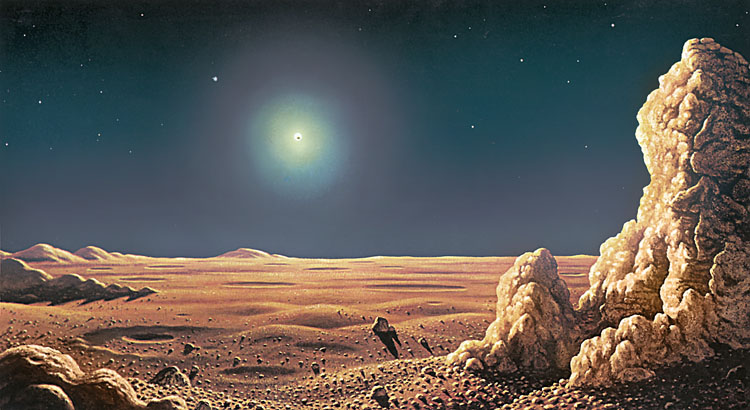
Title: “Mars Desert by David A. Hardy (1972)”
Caption: “For his 1972 book with Patrick Moore, Challenge of the Stars, Hardy painted this scene on Mars based on black-and-white images of Mars sent back by the Mariner probe in 1965. These showed Mars to be disappointingly Moonlike, with craters; later missions, and especially Viking, showed it to be a much more interesting world! They also showed the dark blue sky to be inaccurate.”
Astronomical artists are sometimes divided into First Generation and Second Generation (and I suppose we now have even more). The first group were pioneers; they were the first in their field and had nothing to work with but their own knowledge, observations, intuition, and talent. They include James Nasmyth, who in 1874 made models of the Moon’s surface and photographed them against a black, starry background. Scriven Bolton later used a similar technique for The Illustrated London News. By far the most accurate artist was French astronomer Lucien Rudaux who, because he was an observer, knew what the lunar mountains really look like in profile. His 1937 book Sur les autres mondes (On Other Worlds) is a classic. But the best-known space artist from the 1940s and 50s was the American Chesley Bonestell (see my first blog: http://astronomerswithoutborders.org/component/zoo/item/moon-by-earthlight.html )
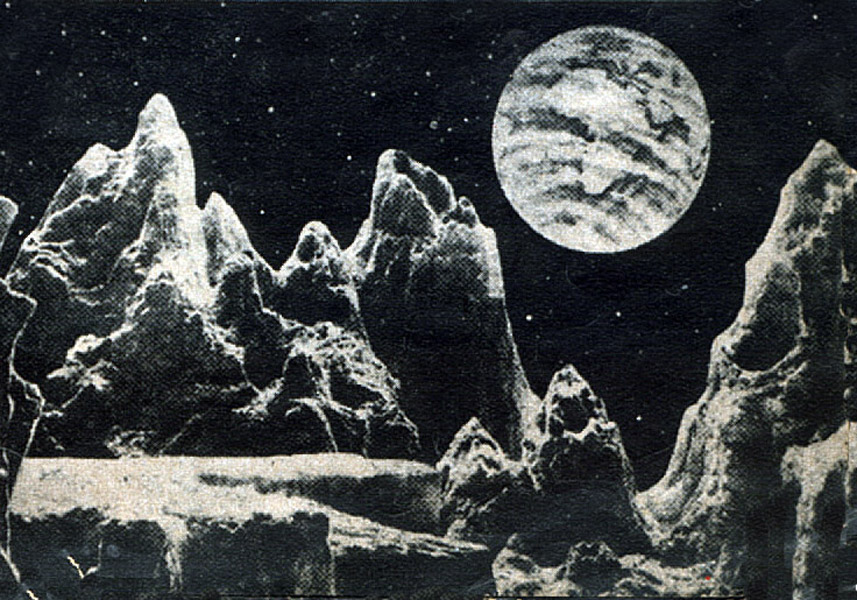
Title: “Moonscape by Scriven Bolton”
Caption: “Scriven Bolton had numerous works published in the Illustrated London News in the early 20th century. Some of Boltons’ lunar scenes employed the novel technique of over-painting a photograph of a plaster landscape model.”
In Britain there was R.A. (Ralph) Smith, who worked with Arthur C. Clarke and the British Interplanetary Society. The Czech artist Ludek Pesek is often cited as one of these pioneers, but in fact his work was not seen until the 1960s and he came to prominence in 1970 for his paintings of Mars in the National Geographic. These artists could only use for reference what they could see through telescopes, or the results from major observatories, such as those at Mt. Wilson and Mt. Palomar. I consider myself fortunate because my own career overlapped the last two, starting as I did around 1950. I did not know until much later that in Russia (USSR) Alexei Leonov, who later became a cosmonaut, and in Japan Kazuaki Iwasaki with his unique airbrush technique, had also started producing their own space art. A few years later saw the dawn of the Space Age, with the launch of Sputnik 1, and we began to see the work of Second Generation artists, who could build upon the works of those who had gone before. By far the greatest influence on these new artists was Bonestell, as shown by almost every painting of the Moon or science fiction book cover bearing the trademark imprint of his sharp, craggy mountains!
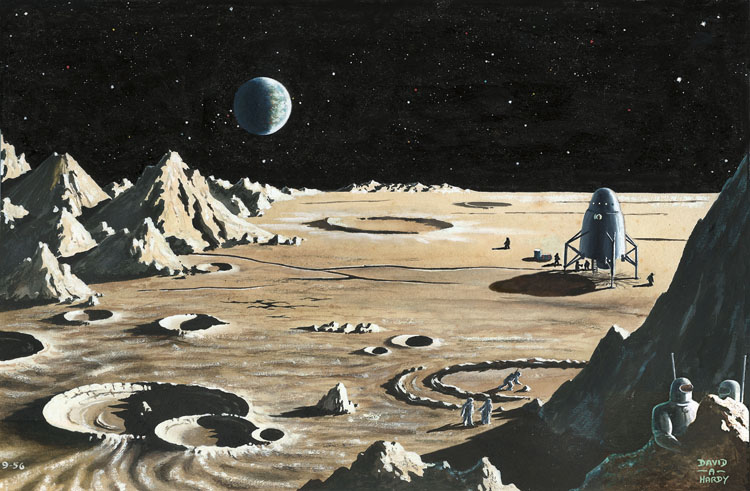
Title: “Moon Landing by David A. Hardy (1956, gouache)”
Caption: “Because Hardy’s main influence at this time was Chesley Bonestell, his lunar mountains are shown as sharp and craggy. But while Bonestell was then depicting a shiny, V2-like winged spaceship, this lunar lander is based on a design by BIS artist and engineer R.A. Smith, and resembles the Apollo lander more closely.”
Even more importantly, in a few short years we began to get back actual images from space, taken by probes and orbiters as they travelled to the Moon, and even landed – or crashed – there. These were followed in the 70’s by images from Mars, Venus, and later even Jupiter. This new data created a quantum leap in our knowledge about the Solar System and the universe. Let’s take a look at how this affected space artists:
Mars was always seen as the most Earthlike planet, it has polar caps, and dark areas which appear to change with the seasons. Due to contrast with the red desert areas, these can appear greenish, so it was natural to assume that there could be vegetation, growing and spreading as the polar cap melted in Spring. Some astronomers, notably Percival Lowell, even believed that they saw ‘canals’, dug by intelligent inhabitants to irrigate the deserts.
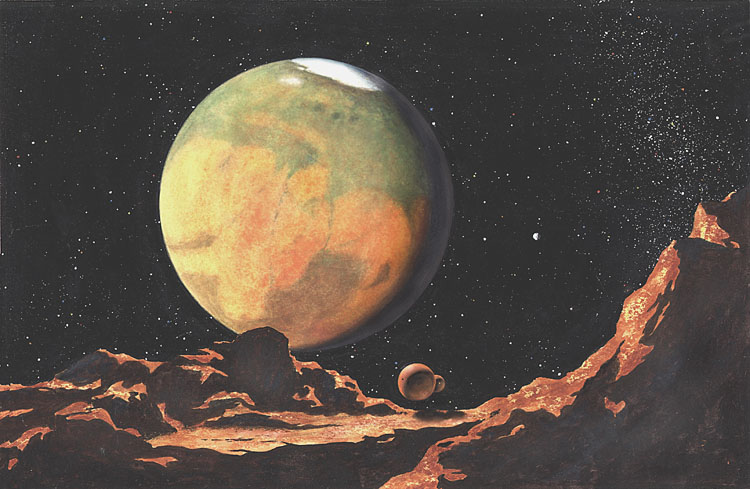
Title: “Mars from Deimos by David A. Hardy (1954, gouache)”
Caption: “The dark markings on the surface of the Red Planet are clearly seen to be due to vegetation, and there are even ‘canals’ extending from the polar cap. A ‘deep space’ craft is seen touching down in the low gravity of the little moon.”
Through telescopic observations using spectroscopes, Mars was known to have an atmosphere, therefore it must have a blue sky – right? Likewise with Saturn’s huge moon Titan. Now we know the sky of Mars is orange-pink and glows down on craters and vast canyons instead of canals. Titan’s sky is also orange, and at least partly opaque with clouds. Venus was long known to possess a dense, cloudy atmosphere which obscures its surface, so it was often depicted with oceans of soda-water (because of the carbon dioxide in its atmosphere) or even with lush prehistoric jungles; or perhaps it was a wind-blown dust-desert, with rocks eroded into strange shapes. Now it is a blistering, hostile hell-planet, with massive shield volcanoes, sulphuric acid rain, and lightning bolts.
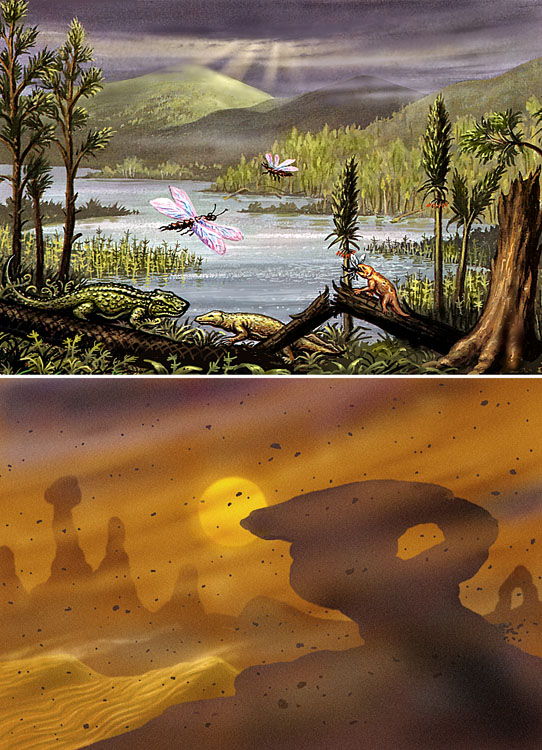
Title: “Views of Venus by David A. Hardy (1955, gouache)”
Caption: “Because the surface of Venus could not be seen under its dense cloud layer, artists were free to use their imagination in showing what might be found. A popular idea was that it could be like a primeval Earth, with water, jungles – and maybe even prehistoric monsters.... But no water vapour could be detected in the atmosphere, so an alternative vision was a dry desert with dust carried by high winds eroding and sculpting the rocks.”
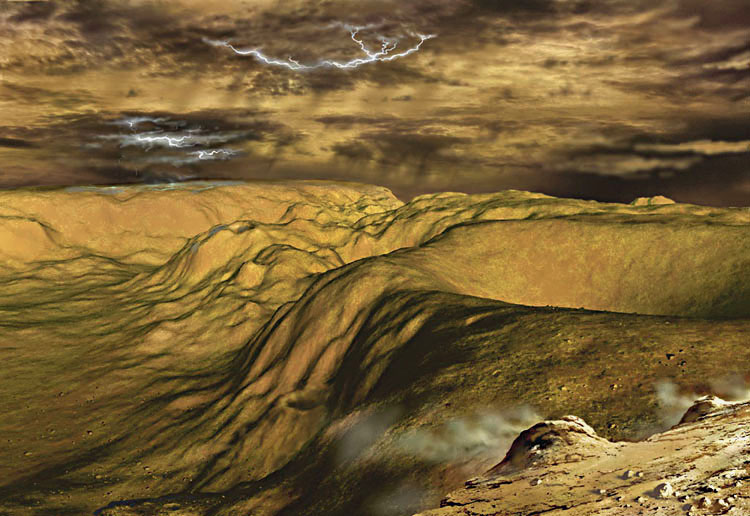
Title: “Volcanoes of Venus by David A. Hardy (2004, digital, from Futures by David A. Hardy and Sir Patrick Moore)”
Caption: “Radar observations show Venus to have giant ‘shield’ volcanoes, probably extinct, but Hardy shows some thermal activity in the foreground. Lightning flashes in the sulphurous cloud layers, and sulphuric acid rain falls in the distance.”
It was believed that one side of Mercury always faced the Sun, so one side was bathed in the Stygian gloom of eternal night while the other roasted in the constant blaze of a huge Sun. Now it is cratered and remarkably Moonlike, with a strange tide-locked rotation of 59 days and a year of 88 days. Jupiter used to have 11 satellites, while Saturn, with nine, was the only planet – perhaps in the entire Universe! – to be blessed with the unique phenomenon of rings. Today we know that all of the outer gas-giants possess such a halo. But who could have forecast the active volcanoes of Io, the giant ravines on Miranda, or the geysers of Triton and Enceladus? Pluto is no longer a planet. Artists didn’t get it wrong; we can only work with the data that we’re given! And we are delighted to find that the Solar System has turned out to be a much more exciting and dynamic place than was once believed.

Title: “Saturn from Titan by David A. Hardy (1972, gouache)”
Caption: “Saturn’s largest moon was known to have an atmosphere, so in his famous painting Bonestell showed it with a blue sky. Knowing that this was composed largely of methane, Hardy asked scientists at Birmingham University what colour this would appear in bulk; hence he painted it as greenish. A team of astronauts has set off a seismic experiment to discover what lies under the icy surface.
In deep space – the province of stars, nebulae and galaxies – the Hubble Space Telescope and developments in terrestrial observing have provided much new material for space artists in the form of black holes, pulsars, and hundreds of extrasolar planets. As each new space probe or satellite sent back its data, and each new discovery was made, artists reviewed and revised their earlier renderings. And they will continue to do so as humankind expands into space. Despite the intrusion of the camera lens into the domain of artists, the paintbrush (or airbrush, or computer) will always be way ahead of it.
David A. Hardy is a Fellow and European Vice President of the International Association of Astronomical Artists (IAAA).
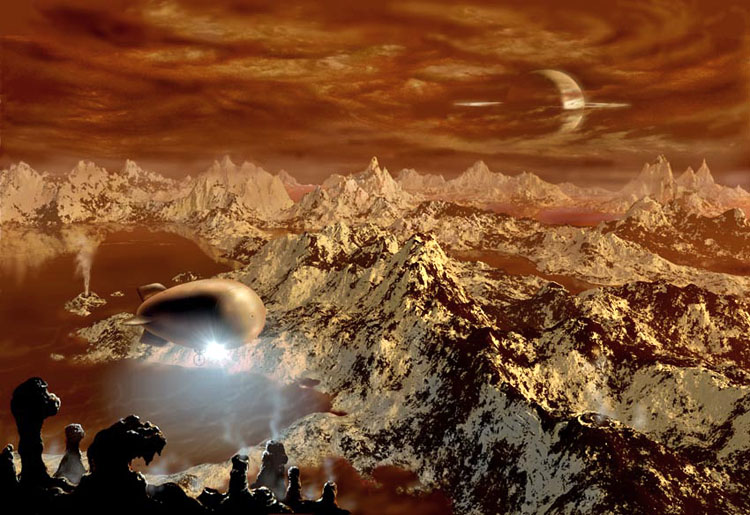
Title: “Titan Landscape by David A. Hardy (2004, digital, from Futures by David A. Hardy and Sir Patrick Moore)”
Caption: “A very different view of Titan, painted before the Cassini/Huygens mission arrived. Saturn is briefly visible through a gap in the clouds, and there are dark lakes of hydrocarbons. There are signs of thermal activity, and a dirigible floats in the atmosphere, sending back images and data.”








Comments